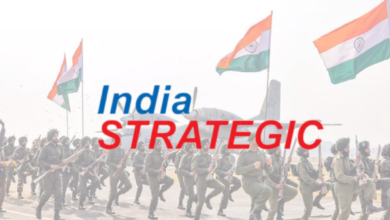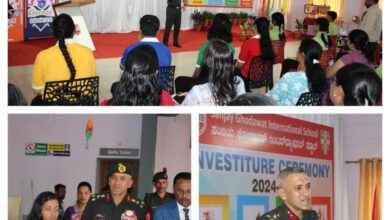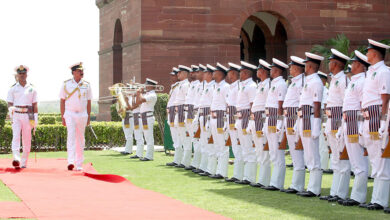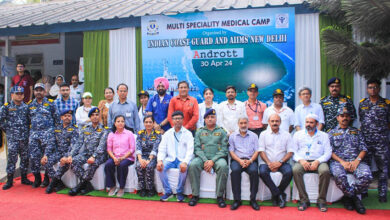INDIA’S 1971 DESERT WAR
By Mahendra Ved
New Delhi. Circumstances, abrupt and beyond my control, changed my deployment as a correspondent assigned to report the impending war in 1971. Instead of going to the East Pakistan border, I was sent to Jodhpur, the Headquarters of the Indian Army’s Southern Command. United News of India (UNI) news agency where I worked as a young reporter, felt that a senior colleague assigned earlier to Jodhpur was needed in New Delhi.

The Army gave uniforms to journalists, to let them merge in the colours of operational identity and camouflage, without any badges or ranks. Reassigned, the colour of my uniform changed from bottle green to khaki to match the terrain. Only the AIR correspondent, representing the official media, wore the Major’s rank.
Preparations were on all across, and the media had been alerted and readied well in advance. Journalists moved, with speed, just as the Movement Orders came from the Ministry of Defence.
The Glamour of War Reporting
Perhaps there was no glamour as we had read in World War II books and comics, and unlike as in the 1991 Gulf War, we were not embedded with fighting units. Nonetheless, after the soldiers, we journalists were the heroes along the warfront as our reports were read eagerly everywhere.
I wrote to my family that while I would be on or around the border, I would be safe and they should not worry.
The Killings of Bengalis
Dark clouds of the impending war had been there for some time due to the mass butchery of Bengalis by the Pakistani army, and the exodus of 10 million of them to India. By the third week of November 1971, there were no surprises in store. A direct skirmish occurred at Hilli on the eastern border between India and Pakistan on November 22-23. That was it.
Brilliant Media Planning
After the state-owned media, primarily the All India Radio, Photo and Film Divisions, UNI and PTI, the two premier news agencies with multiple newspaper and Radio/TV clients in India and abroad, usually got precedence over others.
The arrangements by the Ministries of Defence and Information and Broadcasting were excellent. There were apparently many reporters, both Indian and Foreign, on the Western and Eastern fronts and my own Movement Order number was 124.
I later found that this was because the Government was correcting its mistake of the 1965 conflict when it gave low priority to foreign media personnel who had thronged the Indian capital. Denied access in 1965 when India was slow in responding, they had moved to Pakistan, which received much ‘positive’ publicity. Sections of the foreign media had also lapped up lies broadcast by Radio Pakistan and there was disinformation like the New Delhi’s R K Puram and Connaught Place areas being on fire after air raids. Just lies and nonsense.
The First Air Raid over Jodhpur
A journalist’s task includes reflecting the mood in wartime when the public and the media are part of the larger War Effort. I had just hit the bed on the night of December 5 in Jodhpur, when an ‘enemy’ air raid rocked the city, the largest on India’s southwestern border.

By the time I found my way to the hotel’s terrace in pitch dark, the entire city had already risen to watch the raid and the Indian response with anti-aircraft ack-ack guns. With Diwali-like illumination and more, people watching from their windows and terraces seemed hugely excited. The hotel, however, emptied out the next day, leaving me as its sole guest.
I tried but could not get accommodation within the Army Command Complex, but that could be rationalized. The Southern Command had moved, post-haste, from Pune and was not equipped to cater to civilian needs. I learnt later that a similar problem arose at the Northern Command Headquarters. With two scores of media personnel, all civilians, the Army Commander, Lt Gen Sartaj Singh, a brilliant strategist, protested: “I am here to fight a war, not receive a baraat (marriage) party. Shall I take a blanket off the shoulder of my soldier and give it to the press?”
He did that nonetheless, and the media were able to report on the progress of the war the Northern Command was fighting.
The Daily Army Briefings and Reporting
At the Southern Command Headquarters located outside Jodhpur, Brigadier Ashok Kumar Suri (BGS) held briefings. Once action in Longewala made headlines, a BBC rep, dispatched from London, also chose Jodhpur over other sectors. BBC was trusted by people on both sides of the border, and very often, BBC reports negated what Radio Pakistan said.
With forenoon briefings, it was easy to file quick dispatches latest by lunchtime. I would rush to the Telegraph Office, book a ‘lightning’ Press call, write out my story and before I could complete that, once the phone call matured, shout it out across to a stenographer at the Delhi end.
Our despatches were also sent by the local Telegraph office with welcome and manual speed, but the system was primitive – the Morse Code of Dots and Dashes, and that took very long. The wait for a text message to be over was exhaustive for us. During those tense and exciting moments, other work at the Telegraph Office would cease. The staff, many of them refugees from Sindh after the 1947 Partition, would eagerly absorb our reports while transmitting them.
My dispatches were widely utilized, sometimes even by AIR, although its representative was among us. We all were beating the daily 5 PM national and international briefing in New Delhi. It covered the overall conflict in great detail but left out many sector-wise details. The spokespersons also dealt with diplomacy-related issues. We had a four-hour lead.
The Editor’s Pleasure
To my great satisfaction, the highly efficient and caring Editor of UNI, the late Mr GG Mirchandani, and the News Editor, Mr BRP Bhaskar, sent me this in a telegram: “Congratulations. Your stories are winners everywhere.”
Some of the Army Officers shared my excitement, and offered Rum to celebrate. That was a moment of bonhomie despite the bloodletting the Pakistani army had unleashed.
The Information War as it Happened
This is a less-talked story of how a confident India engaged in elaborate information dissemination. At hand to brief were the Foreign, Defence, Home and Information Secretaries, their spokespersons and the senior military brass. Perhaps unwittingly, a significant part of the foreign media, given access to the war zones, became part of India’s war effort, but that was because they knew the pain of terror that was unleashed in East Pakistan and that India was fighting a just war to help the Bengalis.
This war-time confidence was also evident in New Delhi where Prime Minister Indira Gandhi addressed a 200,000-strong public rally at Ramlila Ground, as Indian Air Force combat aircraft guarded the skies.
The End of war
The Real Action changing the world map concluded in the east, on the afternoon of December 16, 1971. I was in Jaisalmer, hundreds of kilometres away from Dhaka, then Dacca. Not everyone is lucky to be in at the right place at the right time.
Save some post-war reminiscences, there are few references about a sector that was clubbed with the rest of the ‘western’ theatre of the war. But, its Army Commander Lt Gen G G Bewoor, became India’s next Army Chief. And a lieutenant then posted on the Rajasthan border, Zameer Uddin Shah, rose to be the Vice Chief of Army Staff in the rank of Lt Gen.
Battles were fought at Gadra Road. Despite a massive effort, however, Naya Chor, which would have opened India’s access to the green belt in the desert, could not be taken because of the early declaration of the ceasefire. Besides territorial gain, its importance lay in the logistics. Even drinking water for soldiers was being flown from places 150 km away.
How important was the conflict’s Sindh-Rajasthan theatre?
Large tracts of ‘enemy’ territory were captured. The Indian Army pushed its way in deceptive, sandy terrain and through dense minefields. The broad objective was to use the captured territory for possible bargaining at the negotiation table. India derived that wisdom from the 1965 conflict when it had to return the captured territory after signing the Tashkent Agreement of 1966.
However, India gave back again what it had won after the 1972 Simla Agreement.
Longewala
The decisive outcome at Longewala, although a minor outpost with only a Company-level deployment had the world taking note. Longewala found the limelight 26 years later in the shape of ‘Border’, a 1997 Hindi film.
A multi-starrer from Bollywood, it took inspiration from World War films, but on a very limited scale of action on a single night. Directed by J P Dutta and embellished with action and foot-thumping songs, it was a blockbuster.
My surprise gains post-war was to locate in my own office a soldier who had actually fought at Longewala. He had fired his jeep-mounted Recoilless (RCL) gun through that fateful night. Lt. Col Arul Raj (Retd.), whose paintings of officers and events adorn many Indian Army messes and bars, was also a cartoonist and my contemporary at the Times of India.
He was in the tiny artillery detail. I was part of the media team that was at Longewala three days after the battle was over. Raj and I did not meet or interact then. My focus was on his two seniors, Lt Col Mohammed Khursheed Hussain and Major (later Brigadier) Kuldip Singh Chandpuri.
Pakistanis launched a massive armoured attack on this remote outpost in the hope of capturing roads for further access and movement into Rajasthan but the highly motivate Indian Officers led their equally motivated and brave troops very well. They held on against the attackers, climbing on some of their tanks and lobbed hand grenades into them through their hatches. The Indian Air Force was called for support, and as there was no visual night fighting capability with them, its Hunters could come in only with the break of dawn in relentless howling swoops.
According to Gp Capt Dilip Kumar Dass (now Retd), they literally broke the back of the enemy’s armoured thrust and destroyed 27 tanks. The Pakistani force consisted of a Brigade of about 3000 troops and some 40 tanks. Their graveyard can still be seen.
The Pakistanis lost 34 tanks and 500 vehicles in their assault.
Maj Chandpuri’s company, 23rd Battalion, Punjab Regiment, had to choose between attempting to hold out until reinforced or retreat. He held out, and ensured that all his assets were deployed with precision, making the most of his defensive positions and exploiting the errors and weaknesses of the enemy tactics. He was also fortunate that an IAF forward air controller was able to secure and direct aircraft in support of the post’s defence until reinforcements arrived six hours later.
Interviewing Maj Chandpuri on a sand dune, I had asked him what would have happened if he had evacuated or been defeated or outflanked. He replied: “Then, a nice tarred road behind us would have taken the Pakistani soldiers straight to Ramgarh, 25 Km away.” Although Ramgarh was a small township, its loss would have been the first significant loss in that theatre of conflict that India could ill afford.”
Maj Chandpuri was decorated with India’s second highest military award, the Maha Vir Chakra (MVC).
The Pakistani army had rather bad planning due to the overconfidence of their officers.
According to Lt Gen Zameer Uddin Shah, a highly decorated officer of the Indian Army, “The Pakistani commanders made several questionable decisions, including a failure of their strategic intelligence to foresee availability of Indian strike aircraft in the Longewala area, exercising operational mobility with little or no route reconnaissance, and conducting a tactical frontal assault with no engineer reconnaissance.”
Gen. Shah reveals a little-known, but a key change made by one of the war heroes of 1971, Maj Gen JFR Jacob, when he was commanding the Rajasthan area, in transforming the desert defences by replacing camels with jeeps. That led speed to the Indian forces.
Later, as Chief of Staff, Eastern Command, Gen Jacob famously planned the Indian Army’s thrust into East Pakistan.
The Army-Air Force Debate
The Longewala battle left a debate on who and what decided its outcome, the Army or the Air Force. Was it because Maj Chandpuri’s small contingent held out, or was it the Air Force that conducted Hunter sorties at dawn, not just to help out the soldiers on the ground but also to destroy the Pakistani armour and vehicles?
While still there in December 1971, I asked Maj Gen Rustam Faramji Khambatta who visited the media contingent. As he drove away in his jeep, his words were: “The Air Force did it.” Gen. Shah also reinforces this: “Had it not been for the Indian Air Force, our armour of obsolescent AMX-13 tanks — buttressed by a few Russian T-54 tanks — would have been no match for the Pakistani Pattons.”
The War is Over, and My Final Headline
With the war over, on December 17, a message from UNI headquarters asked all those deployed for its coverage to return. But before that, they must file a report highlighting outstanding events in their respective theatres. For me, Longewala was the obvious choice.
I must confess to exaggerating – which none noticed or objected to in the prevailing mood – when I focussed on the huge circles in the sand dunes drawn by confused and panicky movements of Pakistani tanks and vehicles on being bombed by IAF’s Hunters. They fetched a mighty impressive picture from the sky.
This was “reminiscent of the Battle of Al Alamein in Egypt during World War II,” in which the British victory marked the beginning of the end of the Western Desert Campaign against Germany and its allies. The report made great headlines in many newspapers.
I had won my medal through my dispatches.
(The writer reported the conflict in the Rajasthan-Sindh theatre of the 1971 India-Pakistan war. Post-conflict, he returned to it to report the withdrawal of troops in December 1972.)





